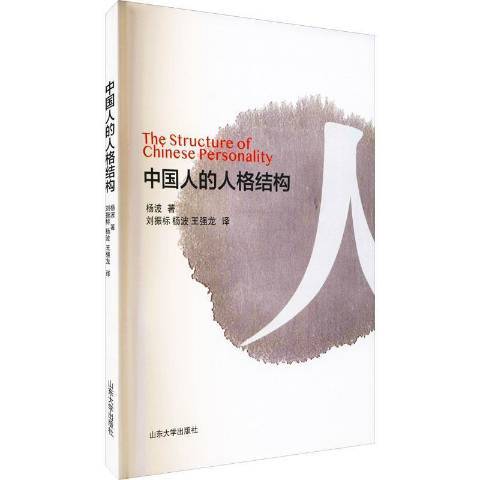《中國人的人格結構》是一本2021年出版的圖書,由山東大學出版社出版
基本介紹
- 中文名:中國人的人格結構
- 作者:楊波
- 出版社:山東大學出版社
- 出版時間:2021年5月1日
- 開本:16 開
- 裝幀:平裝
- ISBN:9787560770055

《中國人的人格結構》是一本2021年出版的圖書,由山東大學出版社出版
《中國人的人格結構》是一本2021年出版的圖書,由山東大學出版社出版 內容簡介 Personality is a concept with many meanings. Philosophers, ethicists, jurists, educators, writers and psychologists all study personality with ...
人格是共同性與差別性的統一,是生物性與社會性的統一。統合性 人格是由多種成分構成的一個有機整體,具有內在統一的一致性,受自我意識的調控。人格統合性是心理健康的重要指標。當一個人的人格結構在各方面彼此和諧統一時,他的人格...
人格結構是指法國人格主義用語。指人的精神活動的結構。他們主張研究完整的人,認為研究完整的人,不僅應從哲學,而且也要從心理學、社會學、切史學、人種學等具體科學進行研究,而那些具體科學的研究只觸及人的自然的存在,不觸及人的...
中國理論 北京大學心理學系王登峰、崔紅等人對中國人人格結構的有益探討,相對於西方的“大五”人格結構,由中國辭彙分類中得出的“大七”人格結構無疑更加符合中國人的實際情況,更加接近中國人人格的真實狀態。中國人的人格特點(I):...
國 家 中國 類 別 心理 地區: 大陸 語言: 簡體中文 內容簡介 人格類型一旦形成,很難改變。無論在壓力的環境裡還是在安定的情況下,思想內在和行為表象都不會完全進另一類價格人的特色,繼續保持屬於自己的顧慮和缺點。任何一型...
第四編 西方人格結構與中國人的人格 25.測量中國人的人格:QZPS或NEO PI—R 26.中國人有沒有獨立的“神經質”人格維度 27.西方“外向性”人格維度內涵的中西方差異 28.中國人的“開放性”——西方“開放性”人格維度與中國人...
北京大學心理學系的王登峰和崔紅(2003)採用西方成熟的人格研究途徑,即辭彙學假設,編制了中國人人格量表(Qingnian Zhongguo Personality Scale,QZPS)來探討中國人的人格結構。他們選取了1520個形容詞進行了好惡度、意義度、熟悉度和現代...
人格(個性)的心理結構 人格(個性)包含哪些心理成分,以什麼方式構成為統一體的,這是人格心理學家長期以來力求解答的問題。這個問題的解決不僅有利於確定人格測量和鑑定的標準,而且可以提高培養人格的教育水平。 中國心理學家一般認為...
應注意,現階段人格結構理論都屬於假說,實證基礎都並不十分足夠。人格心理學界未提出新的較優的人格結構理論。結構理論 西格蒙特·弗洛伊德曾提出著名的冰山模型(意識、潛意識、前意識),潛意識在冰山之下,前意識在水的界面之間,意識...
從最一般的意義上說,認知、情感、意志三種心理成分是人格的最基本的構件。它們的和諧發展在人格的健全上意義重大。方俊明教授就把知、情、意三方面達到高層次的發展水平且協調配合得很好的均衡高型的心理結構看作是健全的人格結構。從...
認為心靈是一個先在性的概念:從本體論看,它是一個實體;從現實存在看,它是一個自律性的主體;從人類個體看,它是一個整體的人格。心靈或人格結構是由意識(自我)、個體潛意識(情結)和集體潛意識(原型)等三個層面所構成。人格 成...
二、融合的理想人格對現實人格的影響 第四章 中國國民人格特徵的實證研究 第一節 中國古代現實人格的實證研究 一、作品選定 二、古代現實人格的因子分析 三、古代現實人格的內容分析 第二節 近代中國人的人格結構及特徵 第三節 ...
基於“道家”這一大的傳統文化背景,探討了道家人格的概念、測量、功能及由對道家人格的反思衍生出的儒道互補人格。結果發現:(1)道家人格結構理論模型是一個由道、道家人性論及人之心理行為特徵所組成的具有層級性的有機結構。(2)...
中國人人格量表 國人人格量表(QZPS)是王登峰、崔紅經過多年的努力編制完成的測量中國人整體人格維度和特點的綜合性人格量表,已經經過心理測量學檢驗,並已經取得了明確的信度和效度,可以廣泛套用。中 ...
《中國人的人格》是2016年工人出版社出版的圖書,作者是胡適。內容簡介 本書是對胡適關於人生、社會、文藝、教育等方面的散文、演講及論文的收集和整理,展示了他以人的啟蒙為中心的思想發展軌跡。在書中,胡適更多的是真誠勸告和諄諄...
人格結構 人在不同時間和情景中都保持某種行為形式和一致性;(一)獨有特質與共同特質 在某一社區里,人都有一些共同特質,但是個人身上強度不一樣,在一個人身上不同時間也不一樣;(二)表面與根源特質 表面特質一個人外部表現的...
